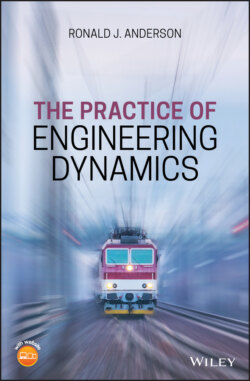Читать книгу The Practice of Engineering Dynamics - Ronald J. Anderson - Страница 2
Table of Contents
Оглавление1 Cover
2 Preface
3 About the Companion Website
4 Part I: Modeling: Deriving Equations of Motion 1 Kinematics 1.1 Derivatives of Vectors 1.2 Performing Kinematic Analysis 1.3 Two Dimensional Motion with Constant Length 1.4 Two Dimensional Motion with Variable Length 1.5 Three Dimensional Kinematics 1.6 Absolute Angular Velocity and Acceleration 1.7 The General Acceleration Expression 2 Newton's Equations of Motion 2.1 The Study of Motion 2.2 Newton's Laws 2.3 Newton's Second Law for a Particle 2.4 Deriving Equations of Motion for Particles 2.5 Working with Rigid Bodies 2.6 Using in the Rigid Body Force Balance 2.7 Using in the Rigid Body Force Balance 2.8 Moment Balance for a Rigid Body 2.9 The Angular Momentum Vector – 2.10 A Physical Interpretation of Moments and Products of Inertia 2.11 Euler's Moment Equations 2.12 Throwing a Spiral 2.13 A Two Body System 2.14 Gyroscopic Motion 3 Lagrange's Equations of Motion 3.1 An Example to Start 3.2 Lagrange's Equation for a Single Particle 3.3 Generalized Forces 3.4 Generalized Forces as Derivatives of Potential Energy 3.5 Dampers – Rayleigh's Dissipation Function 3.6 Kinetic Energy of a Free Rigid Body 3.7 A Two Dimensional Example using Lagrange's Equation 3.8 Standard Form of the Equations of Motion
5 Part II: Simulation: Using the Equations of Motion 4 Equilibrium Solutions 4.1 The Simple Pendulum 4.2 Equilibrium with Two Degrees of Freedom 4.3 Equilibrium with Steady Motion 4.4 The General Equilibrium Solution 5 Stability 5.1 Analytical Stability 5.2 Linearization of Functions 5.3 Example: A System with Two Degrees of Freedom 5.4 Routh Stability Criterion 5.5 Standard Procedure for Stability Analysis 6 Mode Shapes 6.1 Eigenvectors 6.2 Comparing Translational and Rotational Degrees of Freedom 6.3 Nodal Points in Mode Shapes 6.4 Mode Shapes with Damping 6.5 Modal Damping 7 Frequency Domain Analysis 7.1 Modeling Frequency Response 7.2 Seismic Disturbances 7.3 Power Spectral Density 8 Time Domain Solutions 8.1 Getting the Equations of Motion Ready for Time Domain Simulation 8.2 A Time Domain Example 8.3 Numerical Schemes for Solving the Equations of Motion 8.4 Euler Integration 8.5 An Example Using the Euler Integrator 8.6 The Central Difference Method: An Method 8.7 Variable Time Step Methods 8.8 Methods with Higher Order Truncation Error 8.9 The Structure of a Simulation Program
6 Part III: Working with Experimental Data 9 Experimental Data – Frequency Domain Analysis 9.1 Typical Test Data 9.2 Transforming to the Frequency Domain – The CFT 9.3 Transforming to the Frequency Domain – The DFT 9.4 Transforming to the Frequency Domain – A Faster DFT 9.5 Transforming to the Frequency Domain – The FFT 9.6 Transforming to the Frequency Domain – An Example 9.7 Sampling and Aliasing 9.8 Leakage and Windowing 9.9 Decimating Data 9.10 Averaging DFTs
7 A Representative Dynamic Systems A.1 System 1 A.2 System 2 A.3 System 3 A.4 System 4 A.5 System 5 A.6 System 6 A.7 System 7 A.8 System 8 A.9 System 9 A.10 System 10 A.11 System 11 A.12 System 12 A.13 System 13 A.14 System 14 A.15 System 15 A.16 System 16 A.17 System 17 A.18 System 18 A.19 System 19 A.20 System 20 A.21 System 21 A.22 System 22 A.23 System 23
8 B Moments and Products of Inertia B.1 Moments of Inertia B.2 Parallel Axis Theorem for Moments of Inertia B.3 Parallel Axis Theorem for Products of Inertia B.4 Moments of Inertia for Commonly Encountered Bodies
9 C Dimensions and Units
10 D Least Squares Curve Fitting
11 Index
12 End User License Agreement
